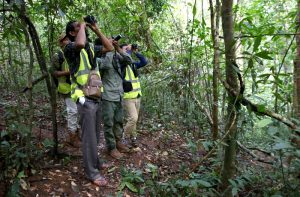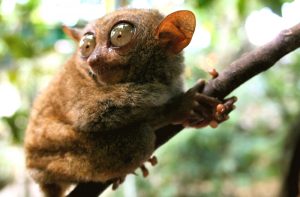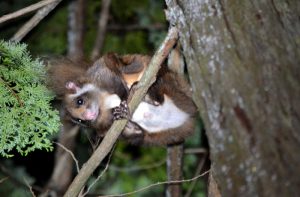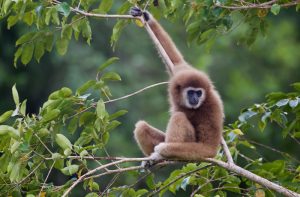 Keep an Eye Out for Gibbons in Cambodia’s Mondulkiri
Keep an Eye Out for Gibbons in Cambodia’s Mondulkiri
A drive through the rolling hills of Mondulkiri leads guests to the Jahoo Gibbon Camp in Keo Seima Protected Forest. Time spent here affords the opportunity to observe one of Asia’s most intriguing and endangered primates, the gibbon. The Jahoo Gibbon Camp is a responsible tourism and conservation project, providing opportunities to trek deep into the core of Keo Seima Wildlife Sanctuary. The sanctuary forms part of a critical wildlife corridor which covers a significant part of Mondulkiri province and crosses into neighboring Vietnam as part of six protected reserves and national parks. Seima protected Forest is owned by the indigenous Bunong community and monitored by Wildlife Conservation Society. Embarking on long and fascinating treks, visitors also regularly see (besides gibbons) black-shanked doucs and elephants.
 On the Lookout for Tarsiers in Sulawesi
On the Lookout for Tarsiers in Sulawesi
Covering an area of more than 8000 hectares, Tangkoko Batuangus Nature Reserve is home to pristine forest, secluded coastline and impressive off shore coral gardens as well as a plethora of mammals, birds and reptiles. Alongside black macaque monkeys, cuscus and red-knobbed hornbills, spectral tarsiers are also found living in family groups within the trees, leaving at night to hunt for insects. We head into Tangkoko Batuangus Nature Reserve before sunrise, where with the assistance of a ranger, we wait close to their homes to which they return after feeding. On the way back guests pass-by the park’s basic research station, which is studying the groups of Celebes crested macaques living within the reserve.
 Japan’s Night-Flying Squirrels
Japan’s Night-Flying Squirrels
Nestled in the southern Japan Alps, Karuizawa is a forested haven popular with Tokyoites in search of their green fix. With plenty of mountain streams, warm hot springs and stunning mountain vistas, it is the perfect place to get away from it all.
As well as its lush natural beauty, Karuizawa is also home to a variety of wild animals. There are many species of birds and mammals to be found here, but by far the most adorable is the Japanese giant flying squirrel (known locally as the musasabi). Endemic to Japan, it is relatively common and found from central Japan to the southern tip, but Karuizawa is known to be the best spot in the country if you are hoping to catch a glimpse of one in flight.
Destination Asia Japan can arrange for your clients to join a 90 minute nighttime group tour led by a local nature conservation company. Guests listen to a short lecture about the squirrel before heading out under cover of darkness to watch their ghostly flights with the help from some soft lighting.
 See the Swinging Red-Shanked Douc in Da Nang
See the Swinging Red-Shanked Douc in Da Nang
Not far from a hustle and bustle of Da Nang City in Vietnam, a number of red-shanked douc live wild on the Son Tra peninsular. A protected area, more than 1,000 monkeys are believed to live in troops in the North part of Son Tra Peninsular. Red-shanked doucs are an endangered species on the Red List of threatened species worldwide. These rare troops can be seen in the early morning and late afternoon while feeding on leaves in the trees. We wake early and head out on a trek up into the hills to see these beautiful animals in the wild. As well as observing the monkeys, it’s a chance to appreciate the unique landscape of this peninsular that has also become affectionately known as Monkey Mountain Da Nang.
 Head Off-track to the Phuket Gibbon Rehabilitation Center
Head Off-track to the Phuket Gibbon Rehabilitation Center
See a different side of Phuket during this half day bicycle tour that ventures away from the beaches and into the quiet northeastern side of the island. Leaving the main roads behind we cycle through rubber tree and pineapple plantations, making our way towards the Phuket Gibbon Rehabilitation Center. Here it is possible to see how gibbons are cared for before being released back in to the rain forest.
The center is located within the boundaries of Khao Phra Theaw National Park and is home to endangered species of apes rescued from illegal use in tourism trade. Here they are rehabilitated before being released back in to the wild. Hearing the sound of the gibbons call through the jungle is a truly wonderful experience. While the majority of the gibbons are kept far away from visitors to limit human contact, it is a great place to learn about environmental issues and wildlife on Phuket Island.